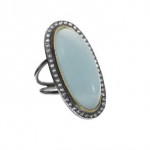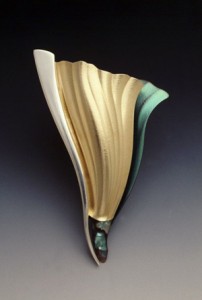Depending on the type of line you use in a jewelry design, its thickness, and direction, you can invest the piece with meaning. It can affect the impact your piece has on viewers and whether they continue to look at your work or walk away. Continue reading
Thinking about Branding
Branding. The buzzword of the 21st century.
The time to start thinking about your brand is the moment you start planning your production line. Brand decisions affect everything–from the type of jewelry you make to the materials and techniques you use, to your Facebook page, to the clothes you wear to show off or complement your jewelry. Having your brand clearly in mind can save you going down unprofitable, confusing, or time-consuming side paths.
Branding is all about recognition. It not only lets customers immediate identify your product but associate it with the tangible and intangible characteristics of that product: quality of materials and workmanship, design idea, price point, audience, cachet, dependability, and even the personality of the manufacturer. Brands live or die on their ability to deliver on those expectations consistently. Continue reading
Lines and Gesture in Jewelry Design
Do you draw conclusions about your friends, family members, doctors, or first grade teachers from their handwriting: neat, repressed, artistic, bold and so on? In the same way, the line gesture in your work tells its own story. Continue reading
Quote for Monday, August 17, 2015
Aside
“To those who need encouragement, remember this: Dr. Seuss’s first children’s book was rejected by twenty-three publishers. The twenty-fourth publisher sold six million copies.”
Ann Landers
Surface Lines in Jewelry Design
While lines in jewelry design are often used to create movement or to guide a viewer’s eye around a piece, lines can do more. Artists can use lines to enhance or emphasis a surface. Continue reading
All the Gems We Never Loved Before

18kt YG and sterling ring, set with oval aquamarine (20.72ct) and white brilliant cut diamonds (0.705ct TW). Photo courtesy Todd Reed, Inc.
It’s been a truism that, for gemstones to sell, they had to be highly transparent, free from inclusions, and of good to excellent color, not to mention of the best modern cuts.

18kt YG and sterling ring set with three fancy cut diamonds, and round white brilliant diamonds. hoto courtesy Todd Reed, Inc.
That is changing, however. Imaginative jewelry designers now showcase the individuality and beauty of pale pastel and translucent varieties of gems such as aquamarine. Old-fashioned rose cuts Continue reading
Guiding Lines in Jewelry Design
One of the most common uses of line in design is to gently (or not so gently) tug the viewer’s eye in a guided tour of the work. They can do this because lines usually have direction. They lean forward or back. They curl around, widen and thin. Artists can use this directional tendency to tell the viewer: “See this? Now, see this? Now look over here.” Continue reading
Find Your Customers: Do Your Own Market Research
Hiring a professional to do market research for you is expensive; it can run thousands of dollars. And while there may be a day you want to hire someone to do it for you, in the beginning, you may be able to do much of your market research yourself. Continue reading
What Makes “Line” in Jewelry Design?

Ridge peaks and places where two dissimilar materials meet are seen as lines. Floating Free, by Betty Helen Longhi. Courtesy of the artist.
Line is the most individual of marks. It is the first mark we make as children. Lines are the result of movement—stick in the sand, pen on paper. Because we each move with a different type and level of intention, a different force–whether we’re talking with our hands or doing daily chores–each of us draws or writes with a different line quality. In fact, the lines we make are so intimately tied to our unique ways of moving, that each of us has a unique signature, used for centuries for identification. Although how long that will last in a digital age is anyone’s guess. Continue reading
Unlimited or limited production?
When deciding to make a production line of your artisan jewelry, an important consideration is whether your line will be unlimited or limited.
You may want to start out with an unlimited line, making as many copies of a piece as you can, especially if the design strikes a chord with buyers and sales are very good. However, depending on where you’re selling the pieces—say a department store chain or catalog—you can end up investing a lot of time in the making, and a lot of money in materials and supplies. Continue reading
